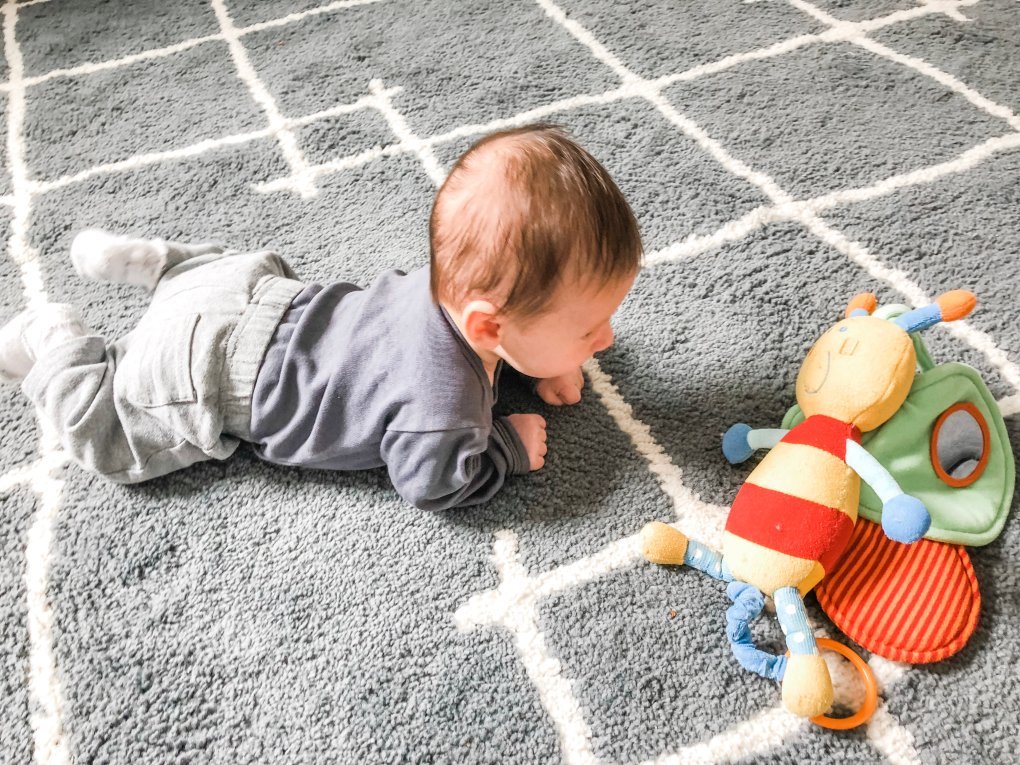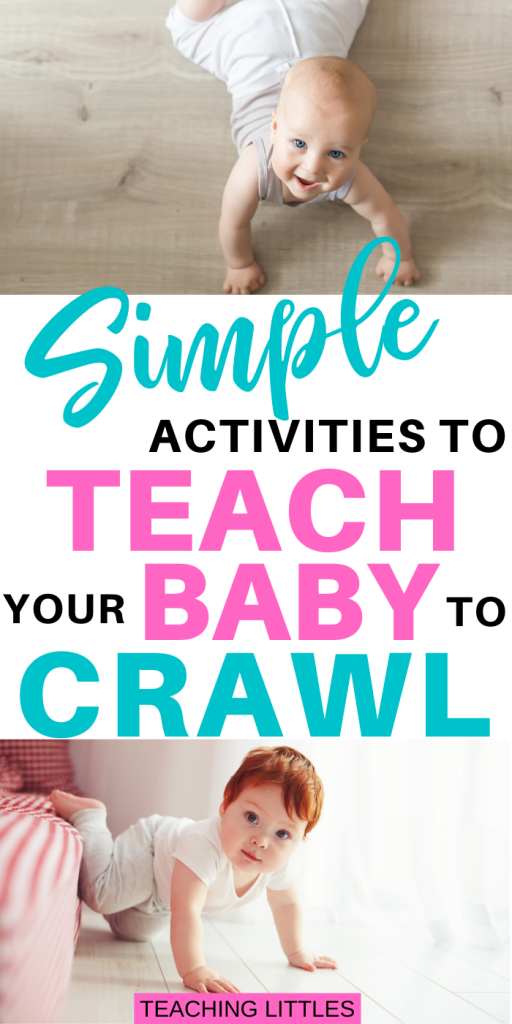Watching your baby or toddler learn to walk or crawl is as exciting as it is scary.
Whether they start exploring early, at a typical age, or even later than most kids, children develop at their own rhythm and pace.
Encouraging kids to start walking or crawling can be confusing, and most parents don’t know where to start. They don’t want to become an overbearing helicopter parent, but want their child’s motor skills to progress without delays.
What Age do Babies Start Crawling?
Crawling is an exciting milestone that most babies will reach between 6-10 months of age. It may take some infants a little longer, but they will get there in their own time.
You’d be surprised how quickly your child will pick up crawling once they are given the opportunities and motivation. Giving your baby exposure to activities that encourage crawling will help get them there sooner.
Encouraging exploration is major as it is not only a physical activity, but a mental journey enabling curiosity, discovery, adaptation, etc.

How Babies Learn to Crawl
As your baby starts crawling they are developing fine and gross motor skills, balance, and hand-eye coordination. In addition, your baby is learning to have spatial awareness, increase visual skills, and of course, physical strength!
They’ll be strong enough to hold up their weight and maintain balance as they move along the floor.
In addition, they’ll use their eyes to focus on a destination as they watch their hands inch forward. Knowing how these skills all interact with each other is important to getting your baby crawling.
Why Crawling is Important
Crawling is vital for babies to strengthen their neck muscles, allowing them to hold their head upright.
It also improves strength in the arms, hands, and fingers for fine and gross motor skills and provides sensory stimulation to all the joints on the front of their body.
The Hands and Knees Position
Babies have different ways of learning to get around. Some keep their elbows on the ground to pull themselves forward (commando crawl), others stay on their bellies and scoot around, some skip crawling and just walk, but most get up on all 4’s (hands and knees) to get around.
The best way for your baby to learn to crawl is on hands and knees. This position provides numerous benefits to your baby through toddlerhood and beyond which commando crawling does not.
Crawling is shown to make a huge difference in children’s motor skills which become more evident when your child reaches school age. The muscles that will develop because of crawling are important for good posture, handwriting, and even athletics.
When babies crawl on hands and knees, they are receiving pressure to most of their joints, including wrists, fingers, and elbows. This helps them be more aware of where their body is in space and develop and strengthen muscles that will be useful as they grab, explore, and manipulate objects.
In my experience working with children, I have seen many school-aged kids with weak muscles, poor posture, sloppy writing, and overall decreased body awareness.
Once I find out that they never crawled, I realize what an important skill it is when they are young to carry over the strengthening as they get older.
This post provides some more great benefits of Why Crawling and Creeping are So Important
9 Tips and Activities to Teach Your Baby to Crawl
The balance of protecting children yet enabling them to learn and develop to the very best of their abilities isn’t easy, but with the tips below, parents can help encourage them to walk and crawl with confidence.
Below are some some activities to teach your baby to crawl on all 4’s. The more opportunities you give your baby to practice, the better crawlers they’ll become.
1. Tummy Time

Tummy time is an activity that can be done as a newborn and is essential to helping your baby develop strength in his or her arms and neck. Before crawling, your baby should show some enjoyment in tummy time.
Many babies can get frustrated from being on their tummy, but keeping them in this position as often as you can will get them acquainted to it quickly. Once you’re ready for your baby to start crawling, they should be able to push themselves up with their arms and keep their head and neck erect in the tummy time position.

If your baby really doesn’t like tummy time, try some of these ideas:
- Prop them up on a Boppy Pillow so their chest and neck can be elevated.
- Place engaging toys or books a safe distance away.
- Use a floor mirror so they can see their reflection and try to reach it.
- Use a tummy time water mat or sensory blanket underneath them to keep them entertained.
- Use sensory tactics like giving them a massage, signing to them, or rubbing soft or bumpy toys or objects along their body.
For more ideas, check out Tummy Time Tips from Just Simply Mom.
2. Use or make a tunnel

Creating a simple obstacle course can be very motivating for your baby. A Pop Up Tunnel Tube can get your baby crawling from one end to the next.
You can also create a makeshift version of this by taking two chairs, end tables, or anything at least 2 feet off the ground, and throwing a blanket over it. This will give your baby the illusion of crawling through a tunnel.
Place toys, snacks, or any motivating objects at the other end or somewhere in the middle to see them crawl toward it.
Not only can your baby crawl through an obstacle course, but have them go over, through, or around objects. You can use cones, cushions, or pillows to have your baby try to get around the challenge.
3. Hands down


While propping your baby’s lower body up in the air, you’re forcing them to put their hands down on the ground. This will help them to feel and understand this position while supporting their body weight into their arms.
If you have a bolster or foam roller, that’s great, but you can use different household materials, as well. A couch cushion, bean bag, or large pillow should work just fine.

4. Twist and Turn
While seated, place toys or most-loved objects on the side of your baby, just slightly out of reach. This will encourage your baby to twist and turn to grab them.
Allowing their bodies to move this way will help them to transition from the sitting position to hands and knees. You don’t want them to be too far because they may feel defeated or unsuccessful. Just far enough that they will be able to reach with a slight twist or stretch.


5. Give them room to move
As your baby practices crawling, give them optimal space to move around (while under supervision). Limit the time that they spend in baby gear including, jumpers, activity centers, bouncers, and play pens.
Your baby should only be in this equipment when absolutely necessary (like you need to keep them contained for a certain amount of time). Otherwise, give them free space to roam and practice their new skill.
6. Place objects just out of reach

While your baby is lying down or sitting up, always place toys or objects just slightly out of reach. You want to make it easy enough for them to obtain the object, but not hard enough that it is discouraging.
This will allow their arms to move freely and encourage them to lift their chest and back.
7. Get on their level

Literally get down on the floor and demonstrate how to crawl. Although crawling can come very natural for some babies, others may need more guidance.
Watching you or another child crawl on all 4’s can help them to learn what exactly they should be doing. So get down on the floor and play with them and they’ll love seeing you scoot around the floor.
8. Use your own hands for guidance
Hold your child on all 4’s as you move their arms and legs in an alternating motion. This will get their muscles used to the movementsof crawling.
You may want to start with just moving their arms and then add in their legs. Always keep a motivating toy as an object that could encourage them.
By gently moving their arms forward one after the other, their feet will naturally follow. Once your baby understands and recognizes the movements, it’s important for parents to continue to make their child feel supported, without making every move for them physically.
Crawling with baby doesn’t have to involve controlling their every step. Crawl next to your child and let them take a few, wobbly solo crawls.
9. Encouragement

Use all the excitement you have to get your baby motivated to crawl. Use encouraging words and excitement in your voice so your baby knows how happy you are.
Cheer for every attempt made by your baby, no matter how big or small. Your tone can be one of the biggest motivators for them.
The most important part of your child learning to crawl is knowing they have support. This is important for building resilience.
If they fall, encourage them to get right back up and try again. When they’re confident enough crawling on their own, stand at a distance and have them crawl towards you to get them moving.
10. Start working on motor skills young
Although most children don’t start crawling until around 6 months old, the development of motor skills starts young. It’s important to ensure parents help their child progress through every stage.
Tummy time as a newborn isn’t just a cute way for them to play, it also helps them develop important neck, abdominal and hip muscles that will assist babies with sitting and crawling. Offering your support through every stage can encourage a fearless attitude about crawling and eventually, walking.
11. Use incentives
Your child’s favorite stuffed animal isn’t just an opportunity for a cute photo. One easy way to help baby crawl is to place their favorite toy a little out of reach, while still having the toy be accessible.
Being rewarded for their success by learning to use their body to get to where they want to go is important. When they’re ready, placing the toy further from where they are can really get them moving and developing important motor skills.
Making this activity a game with a reward at the end for walking or crawling a certain distance can keep kids engaged in using their body and make learning this skill more fun.
12. React appropriately when they fall
As difficult as it may seem, not entering a drama spiral when your baby falls is important. Coming out of hard events with support and compassion helps everyone build resilience, but overreacting can create fear.
This is a great long-term life skill that parents and caregivers have a real impact on. For example, when you see your baby fall, your body language, tone, and facial expressions are crucial.
Try not to yell, run, or show panic. Presenting concern, compassion and empathy are the correct response to not discourage their exploration but encourage them to get back up to crawling again.
This is a learning process for not only children, but also parents. Children looks to us for our reactions when things go wrong, so presenting a calm, level-headed response encourages them to not be afraid and try again.
. . . . . .
Enjoy watching your baby develop this new motor skill.
Whether they’re ahead of the curve, right on time, or even a little behind, the best things parents can do is offer support and guidance.
Using the tips above, parents can provide their kids with the confidence they need to explore on their own and develop these crucial skills at their pace, fearlessly.
Simple activities, games, and ways of making crawling fun are a great way to engage children and encourage movement.
Remember, all babies develop at their own pace, so don’t worry too much if they seem a little behind the norm. However, if your baby is over 10 months old and not attempting to scoot or crawl around, consult your pediatrician.


